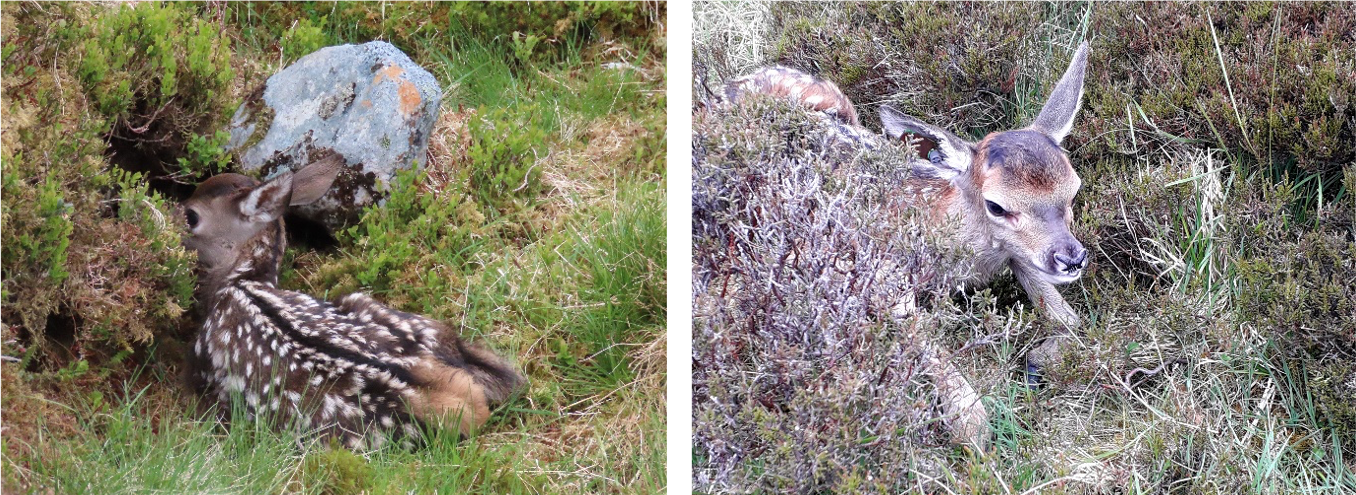The impact of disturbance on red deer
Background
Hillwalking has become increasingly popular in recent years, and Scotland is no exception. However, increased recreational activity in the hills can lead to disturbance of wildlife such as red deer, altering their spatial distribution and behaviour. Even the perception of such disturbances can lead to conflicts between different land users, pitting the "right to roam" against the ecological and economic importance of deer. Here, Eilidh Smith, funded by the Whitehead Trust, with additional support from the Association of Deer Management Groups and the British Deer Society, discusses her PhD work on quantifying and assessing the impact of disturbance on red deer by hillwalkers.
|
Fieldwork
|
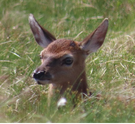
I work on an estate in Glen Lyon, Perthshire, and fieldwork represents the biggest and most challenging component of this project, so far. My data collection focuses on the distribution and movement of red deer, and their behaviour in terms of vigilance and response to disturbance events, all in relation to hillwalker activity. In addition to this, I have also been tagging calves to increase the numbers of marked individuals in the study site so I can track individual movement and begin to assess if disturbance could be affecting the survival rate of calves.
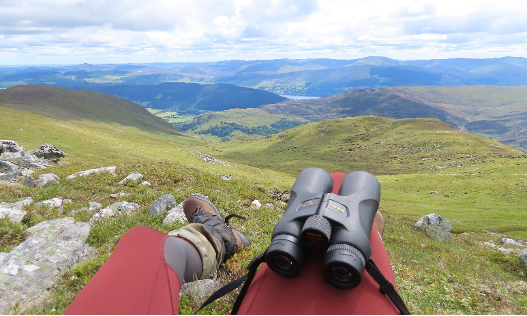
Herd counts and transects
Wherever I go in the study site, and whatever I’m doing, I record deer sightings. I collect information on the number of animals in the group, the type of group, the location, current behaviour, and as much demographic information that I can. I also record when I’ve looked in a particular area and haven’t seen any deer.
In addition to opportunistic herd counts, 4 times a month, over 2 weeks, I walk the hillwalker’s path as a transect and record deer sightings and deer absences. I aim to do this twice on weekdays ('quiet' days of relatively low visitor numbers) and twice on weekend ('busy') days. My route is about 18 km and includes the 4 Munros (mountains > 3000 ft/914.4 m) in the study site. It’s a long day, starting at about 9am and often finishing around 8pm. I take my time and check each area along the way thoroughly for deer.
Transect days are probably my favourite data collection days but the weather can make them extremely challenging, particularly if areas are filled with fog or the wind and rain are making it impossible to see anything. Several times I’ve had to abandon transect day halfway through and try again another day, owing to poor visibility.
Wherever I go in the study site, and whatever I’m doing, I record deer sightings. I collect information on the number of animals in the group, the type of group, the location, current behaviour, and as much demographic information that I can. I also record when I’ve looked in a particular area and haven’t seen any deer.
In addition to opportunistic herd counts, 4 times a month, over 2 weeks, I walk the hillwalker’s path as a transect and record deer sightings and deer absences. I aim to do this twice on weekdays ('quiet' days of relatively low visitor numbers) and twice on weekend ('busy') days. My route is about 18 km and includes the 4 Munros (mountains > 3000 ft/914.4 m) in the study site. It’s a long day, starting at about 9am and often finishing around 8pm. I take my time and check each area along the way thoroughly for deer.
Transect days are probably my favourite data collection days but the weather can make them extremely challenging, particularly if areas are filled with fog or the wind and rain are making it impossible to see anything. Several times I’ve had to abandon transect day halfway through and try again another day, owing to poor visibility.
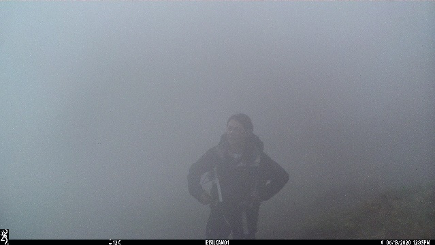
Camera trapping
I currently have 22 cameras deployed across the study site to monitor deer activity and allow comparisons with a previous study in the area (carried out by PhD student Solene Marion, University of St Andrews). Checking and servicing camera traps is a great job for days when visibility is too poor to observe deer, or if I’m lucky enough to be experiencing continuous good weather, I integrate camera checks into transect and behavioural observation days.
I currently have 22 cameras deployed across the study site to monitor deer activity and allow comparisons with a previous study in the area (carried out by PhD student Solene Marion, University of St Andrews). Checking and servicing camera traps is a great job for days when visibility is too poor to observe deer, or if I’m lucky enough to be experiencing continuous good weather, I integrate camera checks into transect and behavioural observation days.
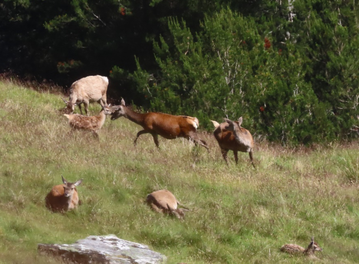
Behavioural observations
Disturbance responses can be dramatic and empty an entire hillside of deer, but they can also be more subtle, in the form of increased vigilance. My behavioural observations involve sitting and scanning groups of deer every 3 minutes to record behaviour, in particular head position which indicates vigilance level. To avoid disturbing the deer myself, I am either positioned at a discreet distance, or take great care to approach unnoticed. When conditions are favourable, behavioural observations can be very relaxing – often in quiet parts of the study site and away from people: it’s just me and the deer. On other occasions, it’s cold and uncomfortable, and occasionally, I am of course joined by hordes of midgies.
Deer spend most of their time eating or resting/digesting, but watching them just hang out being deer is fascinating. I like it when their behaviour tells me there are people on the hillwalker path before I’ve seen or heard anything and, by sitting watching them for long periods, I’m also able to fill in some of the gaps in their movement patterns left by my snap-shot herd counts and camera trap photos.
Disturbance responses can be dramatic and empty an entire hillside of deer, but they can also be more subtle, in the form of increased vigilance. My behavioural observations involve sitting and scanning groups of deer every 3 minutes to record behaviour, in particular head position which indicates vigilance level. To avoid disturbing the deer myself, I am either positioned at a discreet distance, or take great care to approach unnoticed. When conditions are favourable, behavioural observations can be very relaxing – often in quiet parts of the study site and away from people: it’s just me and the deer. On other occasions, it’s cold and uncomfortable, and occasionally, I am of course joined by hordes of midgies.
Deer spend most of their time eating or resting/digesting, but watching them just hang out being deer is fascinating. I like it when their behaviour tells me there are people on the hillwalker path before I’ve seen or heard anything and, by sitting watching them for long periods, I’m also able to fill in some of the gaps in their movement patterns left by my snap-shot herd counts and camera trap photos.
Calf capture
Calf tagging in such a large area is a big challenge but it’s a really rewarding bit of fieldwork. Red deer calves go into hiding while the mother moves off to graze, shifting predator focus away from the vicinity of the calf. These calves are really hard to spot if you don’t already know where they are (and sometimes even when you do!), so calf capture focuses around watching deer from a distance until they reveal the locations of their calves. I then keep a close eye on the spot where the calf goes down.
Once found, the calf is relatively easy to ‘capture’. If young enough, it will simply lie there and hope that you don’t spot it. If the calf is a bit older though, some extra stealth is required, though sometimes even this isn’t enough.
Calf tagging in such a large area is a big challenge but it’s a really rewarding bit of fieldwork. Red deer calves go into hiding while the mother moves off to graze, shifting predator focus away from the vicinity of the calf. These calves are really hard to spot if you don’t already know where they are (and sometimes even when you do!), so calf capture focuses around watching deer from a distance until they reveal the locations of their calves. I then keep a close eye on the spot where the calf goes down.
Once found, the calf is relatively easy to ‘capture’. If young enough, it will simply lie there and hope that you don’t spot it. If the calf is a bit older though, some extra stealth is required, though sometimes even this isn’t enough.
Next steps
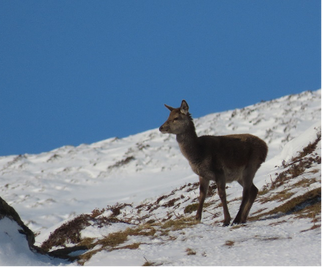
Collaring
This project also aims to obtain more detailed, continuous data on deer movement and behaviour using GPS collars fitted to adult females. Like most things in the mountains, adult capture provides its own set of challenges. Timing is critical, the deer must be darted when they do not have calves that are highly dependent on them, but also not immediately after they’ve conceived, or whilst heavily pregnant. Conditions need to be cool enough so that the deer does not over-heat while anaesthetised, but as the weather gets colder the movements of the deer become less predictable and they are found in larger groups that are harder to sneak up on. To dart a deer we need to be within 40 m – to put that into perspective, during deer management activity, deer stalkers/hunters need to be around 100-200 m from the deer to take their shot.
Collaring efforts will re-commence later this year, and will continue until early Spring next year unless we reach our target number of animals before that.
This project also aims to obtain more detailed, continuous data on deer movement and behaviour using GPS collars fitted to adult females. Like most things in the mountains, adult capture provides its own set of challenges. Timing is critical, the deer must be darted when they do not have calves that are highly dependent on them, but also not immediately after they’ve conceived, or whilst heavily pregnant. Conditions need to be cool enough so that the deer does not over-heat while anaesthetised, but as the weather gets colder the movements of the deer become less predictable and they are found in larger groups that are harder to sneak up on. To dart a deer we need to be within 40 m – to put that into perspective, during deer management activity, deer stalkers/hunters need to be around 100-200 m from the deer to take their shot.
Collaring efforts will re-commence later this year, and will continue until early Spring next year unless we reach our target number of animals before that.
Follow Eilidh on Twitter (@eilidh_mws) for “Deer diary: short stories from the field”.

